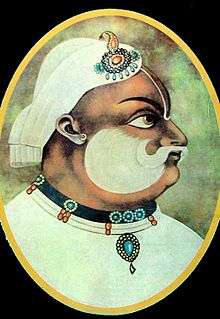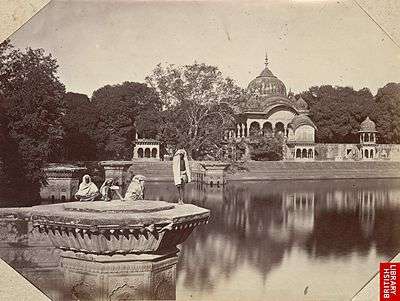Suraj Mal
| Suraj Mal | |
|---|---|
|
Maharaja of Bharatpur Bahadur Jung | |
 Suraj Mal | |
| Reign | r. 1755 – 1763 AD |
| Coronation | Deeg, 22 May 1755 |
| Predecessor | Badan Singh |
| Successor | Jawahar Singh |
| Born | February 1707 |
| Died |
25 December 1763 (aged 56) near Delhi |
| Spouse | Maharani Kishori |
| Issue |
Jawahar Singh Nahar Singh Ratan Singh Nihal Singh Ranjit Singh |
| House | Sinsinwar Jat Dynasty |
| Father | Badan Singh |
| Mother | Devki (Deoki) |
Maharaja Suraj Mal (February 1707 – 25 December 1763) or Sujan Singh was ruler of Bharatpur in Rajasthan, India. A contemporary historian has described him as "the Plato of the Jat people" and by a modern writer as the "Jat Odysseus", because of his political sagacity, steady intellect and clear vision.[1] The Jats, under Suraj Mal, overran the Mughal garrison at Agra and plundered the city taking with them the two great silver doors of the entrance of the famous Taj Mahal which were then melted down by Suraj Mal in 1763. Mughal commanders such as Sayyad Muhammad Khan Baloch vowed to avenge the damage inflicted on the Mughal Empire by the Jats, and Suraj Mal was killed in an ambush by the Mughal Army on the night of 25 December 1763 near Hindon River, Shahadra, Delhi.

Battle of Kumher
Mughal Emperor Alamgir II and his rebellious courtier Siraj ud-Daulah were having a factional feud. Suraj Mal had sided with Siraj. Alamgir sought the help of the Holkar Marathas of Indore. Khanderao Holkar, son of the Maharaja of Indore, Malhar Rao Holkar, laid a siege on Suraj Mal's Kumher in 1754. While inspecting the troops on an open palanquin in the battle of Kumher, Khanderao was hit and killed by a cannonball from the Bharatpur army. The siege was lifted and a treaty was signed between Jats and Marathas, which later proved helpful for Suraj Mal in consolidating his rule.[2][3]
Ahmed Shah Abdali's Fifth Invasion (1759-1760)
After news reached of Ahmad Shah Abdali invading India for the fifth time and marching towards Delhi, Suraj Mal sent five thousand troops to Delhi for its protection. Sensing that the battle between the Afghans and Marathas under Dattaji Shinde was imminent, Ghazi-ud-din retreated from Delhi to Kumher fort under the protection of Suraj Mal. On January 9, 1760 the forces of Ahmad Shah Abdali defeated Dattaji Shinde and his forces at Barari Ghat, where Dattaji Shinde was killed, Jankoji Shinde was wounded and most of the Maratha forces started fleeing. The Jat forces at Delhi retreated after the Maratha defeat at Barari Ghat.
After his victory at Burari Ghat, Ahmad Shah Abdali camped at Khizarabad, south of Delhi. He asked Madho Singh of Jaipur, Bijay Singh of Marwar and Suraj Mal of Bharatpur to present themselves at his court and pay tributes.
Receiving no satisfying reply from Suraj Mal, Abdali marched into Jat territory coming through Shergarh and on February 6, 1760 laid siege to Dig. Marathas regrouped under the leadership of Malhar Rao Holkar who started raids on Afghan camps using guerilla warfare. Ahmed Shah Abdali raised the siege of Dig and marched against Malhar Rao Holkar. In a matter of month, Abdali inflicted several defeats on forces of Malhar Rao Holkar which resulted in Malhar Rao Holkar and his minister Gangadhar Tatya retreating to Jat kingdom of Bharatpur for refuge. Once there, Malhar Rao Holkar began peace talks with Ahmed Shah Abdali.
Abdali then marched and laid siege to the fort of Aligarh on the eastern side of river Yamuna. Aligarh fort came under Suraj Mal’s territory and a garrison under Durjan Sal held the fort at the moment. Though being a fortified and well provisioned fort, Abdali was successful in completely isolating the fort from reinforcements and supplies arriving from Suraj Mal. Durjan Sal understood his precarious position and surrendered the fort to Abdali.
Here Abdali found out that a fresh Maratha force of about 50,000 strong was dispatched from Deccan under the command of Sadashivrao Bhau. Najib-ud-daula persuaded Ahmed Shah Abdali to stay in India for the rainy season and inflict a severe defeat to the Marathas. Abdali made camp at Aligarh and started making allies with Shuja-ud-daula and Ahmed Khan Bangash against the upcoming fight against the Marathas.[4]
Failed Durrani Expedition Against Suraj Mal (Early 1761)
Ahmad Shah Abdali and the Afghans decisively defeated the Marathas at Panipat, but had won no spoils in return. The Maratha army was starving and thus, provided no valuables to be looted. Delhi also, was in no better state as it had been rendered barren and empty due to recent invasions. The Afghan army had not been paid their salaries since the beginning of Abdali’s invasion in 1759. Ahmad Shah Abdali thus, felt a need for money which he demanded Najib-ud-Daula and Shuja-ud-Daula. Najib-ud-Daula persuaded Abdali to ask Suraj Mal to pay tributes to Abdali. With this intention, Najib-ud-Daula presented Nagar Mall and Majlis Rai, who were Suraj Mal’s envoys to Abdali.
The negotiations were unsuccessful and Zinat Mahal's (wife of Alamgir II), requested Abdali not to negotiate with Suraj Mal who had given refuge to Alamgir II’s murderer Ghazi-ud-din. Helpless Abdali ordered an expedition against Suraj Mal with his wazir Shah Wali Khan commanding it, accompanied by Zinat Mahal, Prince Jawan Bakht and Mirza Babur. They set out for Agra on March 7, 1761, but the Afghan army did not cooperate. The Afghan soldiers had not seen their home for almost two years, had not been paid their salaries for almost two years, who after facing death and destruction at Panipat were once again being asked to sacrifice themselves for promise of loot. The Afghan soldiers also remembered the previous time they visited Mathura, when an epidemic of cholera broke out killing countless Afghan soldiers. To stop the soldiers from revolting, Ahmad Shah Abdali decided to return to Afghanistan as swiftly as possible and on March 13, 1761 left Delhi for Afghanistan.[4]
Commemoration
His large cenotaph is at Kusum Sarovar, Govardhan, Uttar Pradesh.[5]
Notable institutes named after him include Maharaja Surajmal Institute of Technology and Maharaja Surajmal Brij University, Bharatpur.
References
- ↑ R.C.Majumdar, H.C.Raychaudhury, Kalikaranjan Datta: An Advanced History of India, fourth edition, 1978, ISBN 0-333-90298-X, Page-535
- ↑ Advanced Study in the History of Modern India 1707-1813, by Jaswant Lal Mehta, pp606
- ↑ Images of Women in Maharashtrian Literature and Religion, edited by Anne Feldhaus, pp185-186
- 1 2 Singh, Ganda (1959). Ahmad Shah Durrani - Father of Modern Afghanistan. Gosha-e-Adab : sole distributers Nisa traders (1977).
- ↑ Cenotaph of Raja Sooruj Mull, Govurdhun. 97140, British Library online collection
Suraj Mal Sinsiniwar Jat Dynasty Born: 1707 Died: 1763 | ||
| Regnal titles | ||
|---|---|---|
| Preceded by Badan Singh |
Maharaja of Bharatpur 1755–1763 AD |
Succeeded by Maharaja Jawahar Singh |